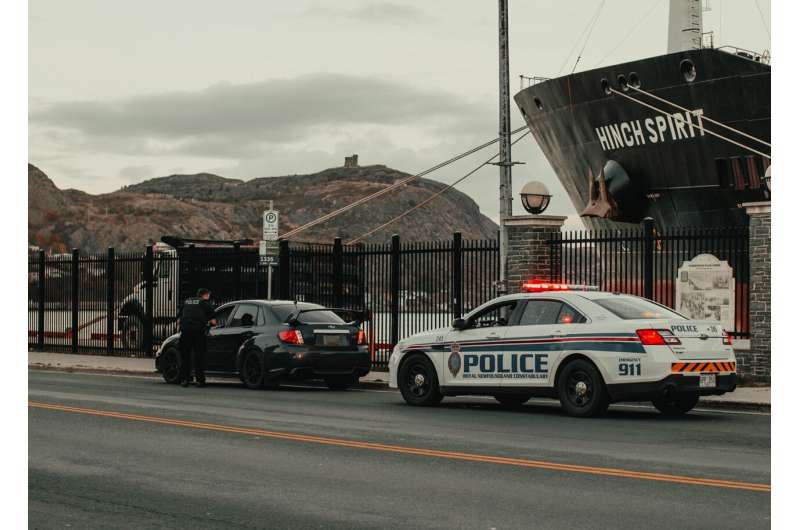Dashcam images offer insight on NYPD officer deployment
Using a deep learning computer model and a dataset containing millions of dashboard camera images from New York City rideshare drivers, Cornell Tech researchers were able to see which neighborhoods had the highest numbers of New York Police Department marked vehicles, a possible indication of deployment patterns.
Their results showed trends in police presence by time of day, neighborhood demographics, proximity to police stations and commercial districts. Among the researchers’ findings: Gramercy Park, in Midtown Manhattan, had the most police vehicles visible in dashcam images—almost 20 times more than Arden Heights/Rossville, in southern Staten Island, which had the fewest. Areas with more police vehicle images included wealthy commercial zones and low-income neighborhoods with higher proportions of Black and Latino residents.
The research, “Detecting Disparities in Police Deployments Using Dashcam Data,” was presented June 12 at the Association for Computing Machinery Conference on Fairness, Accountability, and Transparency (FAccT ’23) in Chicago.
The researchers used thousands of images to train a deep learning model to identify marked police vehicles. While the model could identify police vehicles, it could not account for the reasons they were there. While data on police stops, use of force, searches, criminal incidents and arrests is publicly available, police generally do not provide information on how and where officers are deployed, citing security concerns.
Deployment disparities, the researchers wrote, can result in downstream biases like increased arrests: A neighborhood that’s more heavily policed than another might not necessarily have more crime, just more people arrested for it.
In 2020, the team obtained 24.8 million dashcam images from Nexar, a company that provides rideshare drivers with dashboard cameras. The researchers identified more than 233,000 images containing marked police vehicles. The team then studied the geo-tagged images in context of specific factors such as neighborhood, borough and zone type, and whether the pictures were taken in a bustling commercial area, near manufacturing or in a primary residential location. They also analyzed the images in relation to census data for the area.
The researchers said they see two main benefits to this work: a step toward greater transparency in policing; and the potential for auditing all government agencies for efficiency and equity.
More information:
Matt Franchi et al, Detecting disparities in police deployments using dashcam data, 2023 ACM Conference on Fairness, Accountability, and Transparency (2023). DOI: 10.1145/3593013.3594020
Conference: facctconference.org/
Citation:
Dashcam images offer insight on NYPD officer deployment (2023, July 6)
retrieved 6 July 2023
from https://phys.org/news/2023-07-dashcam-images-insight-nypd-officer.html
This document is subject to copyright. Apart from any fair dealing for the purpose of private study or research, no
part may be reproduced without the written permission. The content is provided for information purposes only.

Using a deep learning computer model and a dataset containing millions of dashboard camera images from New York City rideshare drivers, Cornell Tech researchers were able to see which neighborhoods had the highest numbers of New York Police Department marked vehicles, a possible indication of deployment patterns.
Their results showed trends in police presence by time of day, neighborhood demographics, proximity to police stations and commercial districts. Among the researchers’ findings: Gramercy Park, in Midtown Manhattan, had the most police vehicles visible in dashcam images—almost 20 times more than Arden Heights/Rossville, in southern Staten Island, which had the fewest. Areas with more police vehicle images included wealthy commercial zones and low-income neighborhoods with higher proportions of Black and Latino residents.
The research, “Detecting Disparities in Police Deployments Using Dashcam Data,” was presented June 12 at the Association for Computing Machinery Conference on Fairness, Accountability, and Transparency (FAccT ’23) in Chicago.
The researchers used thousands of images to train a deep learning model to identify marked police vehicles. While the model could identify police vehicles, it could not account for the reasons they were there. While data on police stops, use of force, searches, criminal incidents and arrests is publicly available, police generally do not provide information on how and where officers are deployed, citing security concerns.
Deployment disparities, the researchers wrote, can result in downstream biases like increased arrests: A neighborhood that’s more heavily policed than another might not necessarily have more crime, just more people arrested for it.
In 2020, the team obtained 24.8 million dashcam images from Nexar, a company that provides rideshare drivers with dashboard cameras. The researchers identified more than 233,000 images containing marked police vehicles. The team then studied the geo-tagged images in context of specific factors such as neighborhood, borough and zone type, and whether the pictures were taken in a bustling commercial area, near manufacturing or in a primary residential location. They also analyzed the images in relation to census data for the area.
The researchers said they see two main benefits to this work: a step toward greater transparency in policing; and the potential for auditing all government agencies for efficiency and equity.
More information:
Matt Franchi et al, Detecting disparities in police deployments using dashcam data, 2023 ACM Conference on Fairness, Accountability, and Transparency (2023). DOI: 10.1145/3593013.3594020
Conference: facctconference.org/
Citation:
Dashcam images offer insight on NYPD officer deployment (2023, July 6)
retrieved 6 July 2023
from https://phys.org/news/2023-07-dashcam-images-insight-nypd-officer.html
This document is subject to copyright. Apart from any fair dealing for the purpose of private study or research, no
part may be reproduced without the written permission. The content is provided for information purposes only.
